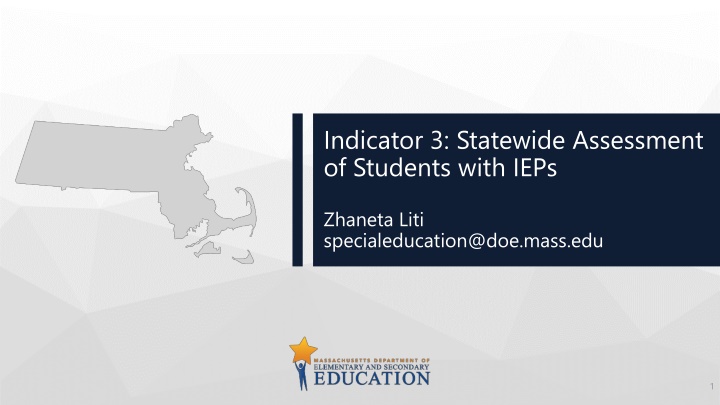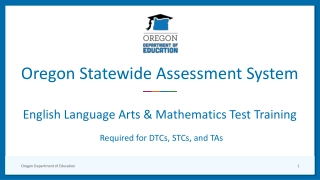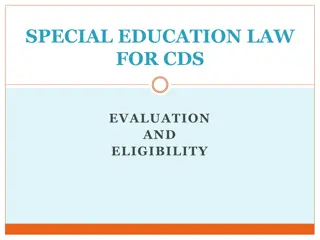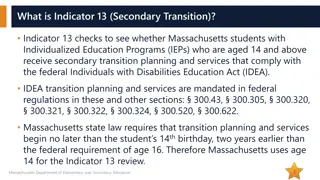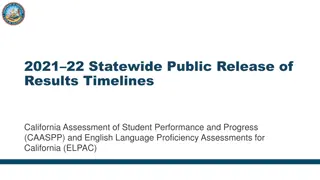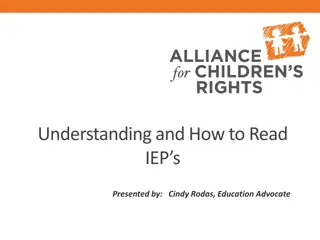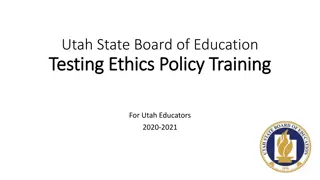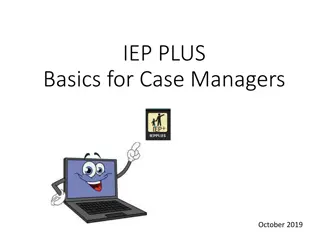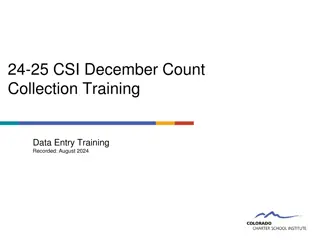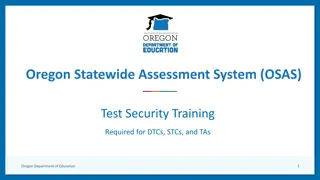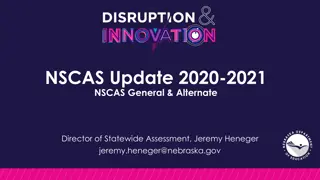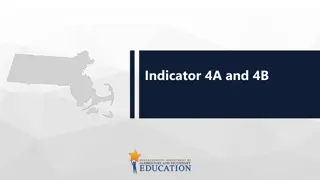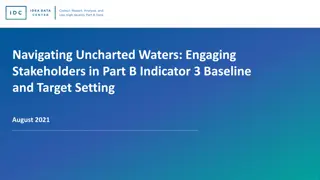Statewide Assessment of Students with IEPs - Overview
Indicator 3 focuses on the assessment of children with Individualized Education Programs (IEPs) in Massachusetts. It includes participation rates, proficiency rates against regular and alternate academic achievement standards, and gap analysis. The data is sourced from the Massachusetts Next Generation MCAS and is calculated for students in Grades 4, 8, and High School. The goal is to ensure high participation and proficiency levels for students with IEPs.
Download Presentation

Please find below an Image/Link to download the presentation.
The content on the website is provided AS IS for your information and personal use only. It may not be sold, licensed, or shared on other websites without obtaining consent from the author.If you encounter any issues during the download, it is possible that the publisher has removed the file from their server.
You are allowed to download the files provided on this website for personal or commercial use, subject to the condition that they are used lawfully. All files are the property of their respective owners.
The content on the website is provided AS IS for your information and personal use only. It may not be sold, licensed, or shared on other websites without obtaining consent from the author.
E N D
Presentation Transcript
Indicator 3: Statewide Assessment of Students with IEPs Zhaneta Liti specialeducation@doe.mass.edu 1
Indicator 3- Assessment Indicator 3 is one of 17 Indicators of Special Education included in the SPP/APR, this Indicator focuses on Assessment of children with IEPs. Indicator 3 includes four separate measurements: o 3A: Participation rate for children with IEPs. o 3B: Proficiency rate for children with IEPs against grade level academic achievement standards (regular assessment). o 3C: Proficiency rate for children with IEPs against alternate academic achievement standards (alternate assessment). o 3D: Gap in proficiency rates for children with IEPs and all students against grade level academic achievement standards (regular assessment). Indicator 3 uses the English Language Arts (ELA) and Mathematics MCAS for students in Grades 4, 8, and High School. 2 Massachusetts Department of Elementary and Secondary Education
3A/Measurement and Data Source 3A measures the Participation Rate percent. This is equal to the number of children with IEPs participating in a state assessment divided by the total number of children with IEPs enrolled during the testing window. This is calculated separately for ELA and mathematics, for students in grades 4, 8, and High School (HS). Includes both students with IEPs enrolled for a full academic year and those not enrolled for a full academic year. For Indicator 3A, the United States Department of Education (USED) determines the participation rate goal and always sets a participation rate no less than 95%. Data Source for Indicator 3: Massachusetts Next Generation MCAS. Massachusetts Department of Elementary and Secondary Education
3B Measurement and Data Source 3B measures the Proficiency rate percent. Proficiency means attaining a score of either Meeting Expectations or Exceeding Expectations on the MCAS. Total number of children with IEPs scoring at or above proficient against grade level academic achievement standards divided by the total number of children with IEPs who received a valid score and for whom a proficiency level was assigned for the regular assessment. Calculated separately for ELA and Math for students in grades 4, 8, and 10. The proficiency rate includes both children with IEPs enrolled for a full academic year and those not enrolled for a full academic year. 4 Massachusetts Department of Elementary and Secondary Education
3C Measurement and Data Source 3C measures the Proficiency rate percent for children with IEPs against the alternate academic achievement standards on the MCAS Alternative Assessment, or MCAS-Alt. The total number of children with IEPs scoring at or above proficient against alternate academic achievement standards divided by the total number of children with IEPs who received a valid score and for whom a proficiency level was assigned for the alternate assessment. In Massachusetts, students are considered proficient if they received a score of Progressing, the highest possible score on the MCAS-Alt, the state's alternate assessment. Calculated separately for ELA and Math for students in grades 4, 8, and grade 10. The proficiency rate includes both children with IEPs enrolled for a full academic year and those not enrolled for a full academic year. Massachusetts Department of Elementary and Secondary Education 5 Massachusetts Department of Elementary and Secondary Education
3D/ Measurement and Data Source 3D measures the gap in performance of students with disabilities compared to all students. Gap calculations in this SPP/APR must result in: the proficiency rate for children with IEPs who were proficient against grade level academic achievement standards for the 2020-2021 school year compared to the proficiency rate for all students who were proficient against grade level academic achievement standards for the 2020-2021 school year. Include all children enrolled for a full academic year and those not enrolled for a full academic year. Only include children with disabilities who had an IEP at the time of testing. 6 Massachusetts Department of Elementary and Secondary Education
How has COVID-19 affected Indicator 3? COVID-19 has had an impact on students' learning and MCAS administration: The federal government granted Massachusetts a waiver to allow us to cancel statewide academic assessments for the 2019-2020 school year. Students were mostly educated remotely, but also in hybrid and in-person environments Students, teachers, and families were required to adapt to changing learning environments. Disruptions and disparities in student access to instruction and assessments led to disparities in learning and achievement. 7 Massachusetts Department of Elementary and Secondary Education
